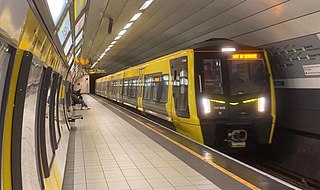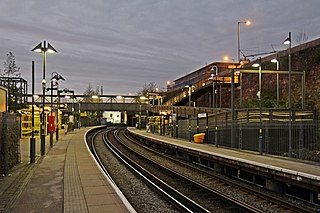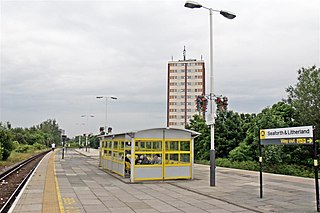
Merseyrail is a metro railway system serving the Liverpool City Region and adjacent areas of Cheshire and Lancashire. Merseyrail operates 66 railway stations across two lines – the Northern Line and the Wirral Line, which are dedicated 750 V DC third rail electrified lines converging into underground sections in the centres of Liverpool and Birkenhead. Merseyrail branding is also applied to stations and ticketing on the City Line, which are within the Liverpool City Region but operated by other train operating companies, predominantly Northern Trains. The City Line services operate on the Liverpool to Manchester Lines and the Liverpool to Wigan Line using a mix of AC electric and diesel trains.

Dingle is an inner city area of Liverpool, Merseyside, England. It is located to the south of the city, bordered by the adjoining districts of Toxteth and Aigburth. At the 2001 Census, the population was recorded at 13,246.

The Cheshire Lines Committee (CLC) was formed in the 1860s and became the second-largest joint railway in Great Britain. The committee, which was often styled the Cheshire Lines Railway, operated 143 miles (230 km) of track in the then counties of Lancashire and Cheshire. The railway did not become part of the Big Four during the implementation of the 1923 grouping, surviving independently with its own management until the railways were nationalised at the beginning of 1948. The railway served Liverpool, Manchester, Stockport, Warrington, Widnes, Northwich, Winsford, Knutsford, Chester and Southport with connections to many other railways.

Herculaneum Dock was part of the Port of Liverpool in Liverpool, England. It was at the south end of the Liverpool dock system, on the River Mersey. To the north it was connected to Harrington Dock. The dock was named after the Herculaneum Pottery Company that had previously occupied the site.

Salthouse Dock is a dock on the River Mersey, England, and part of the Port of Liverpool. It is situated in the southern dock system, connected to Canning Dock to the north, Wapping Dock via Wapping Basin to the south and Albert Dock to the west.

Harrington Dock was a dock on the River Mersey and part of the Port of Liverpool. Situated in the southern dock system, it was connected to Toxteth Dock to the north and Herculaneum Dock to the south.

The Liverpool Overhead Railway was an overhead railway in Liverpool which operated along the Liverpool Docks and opened in 1893 with lightweight electric multiple units. The railway had a number of world firsts: it was the first electric elevated railway, the first to use automatic signalling, electric colour light signals and electric multiple units, and was home to one of the first passenger escalators at a railway station. It was the second oldest electric metro in the world, being preceded by the 1890 City and South London Railway.

The Wirral line is one of two commuter rail routes operated by Merseyrail and centred on Merseyside, England, the other being the Northern line.

Brunswick railway station serves the Toxteth district of Liverpool, England, on the Northern Line of the Merseyrail network. The station serves the nearby district of Dingle and is situated on a short section of track between two tunnels, between the now in-filled Toxteth and Harrington Docks. The station also serves businesses on the Brunswick Dock estate, whch gives it name to the station. The residential area of Grafton Street is reached by steps or ramp from the southbound platform.

The Garston and Liverpool Railway line ran from the St Helens and Runcorn Gap Railway line at Garston Docks to Brunswick railway station, later to central Liverpool. The company was formed on 17 May 1861 and the line opened on 1 June 1864.

Seaforth & Litherland railway station is a railway station in Seaforth, Merseyside, England, on the Northern Line of the Merseyrail network. It also serves the adjacent area of Litherland.

Seaforth Sands was a terminus station located on the Liverpool Overhead Railway at Seaforth, west of Crosby Road South, Knowsley Road and Rimrose Road junctions.

Dingle railway station is a disused underground railway station located on the Liverpool Overhead Railway (LOR), at the south end of Park Road, Dingle, Liverpool. It was the only below ground station on the line. Trains accessed the station via a half-mile tunnel, bored from the cliff face at Herculaneum Dock to Park Road. It is the last remaining part of the Overhead railway, with the surface entrance still standing. The former platform and track area were in use as a garage called Roscoe Engineering until 2015.
Sir Francis Fox was an English civil engineer, who was responsible for the bridges over the Victoria Falls of the Zambesi and Sydney Harbour, the Mersey Railway Tunnel and the Liverpool Overhead Railway, and extending the London Underground. He was awarded a Knighthood by the King on 25 July 1912.
Brunswick Dock railway station was on the Liverpool Overhead Railway, adjacent to Brunswick Dock and in close proximity to the Cheshire Lines Committee's extensive goods yard of the same name.
Langton Dock was a railway station on the Liverpool Overhead Railway, adjacent to the dock of the same name.

Herculaneum Dock railway station was the original southern terminus for the Liverpool Overhead Railway. Actually adjacent to Harrington Dock it was named after Herculaneum Dock, a somewhat larger dock beyond the end of the line. It was opened on 6 March 1893 by the Marquis of Salisbury.
Liverpool in North West England, is a major British city with significant road, rail, and ferry networks, in addition to an international airport and a well-known dock system. As with most other major UK cities, Liverpool's transport infrastructure is centred on its road and rail networks. Public transport services within the city are controlled and run by Merseytravel.

The Harrogate–Church Fenton line was a railway line opened by the York and North Midland Railway between 1847 and 1848 linking Harrogate and Church Fenton.

















